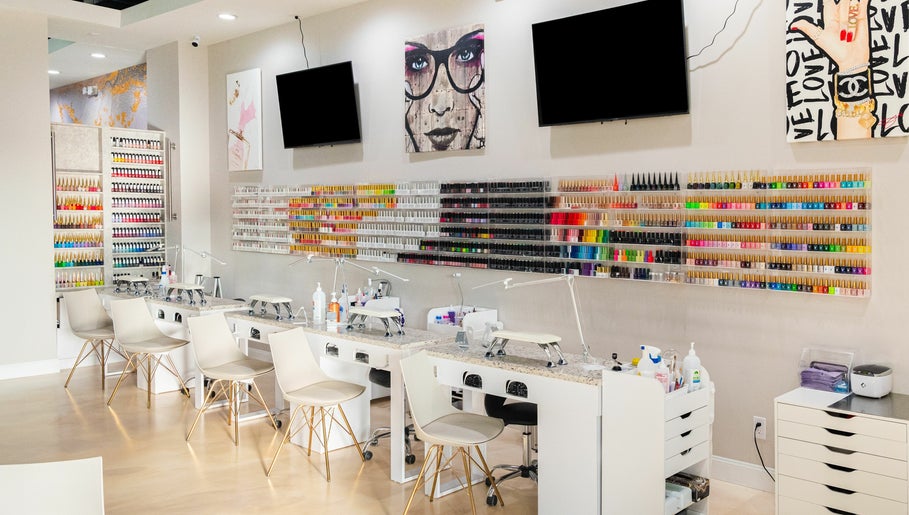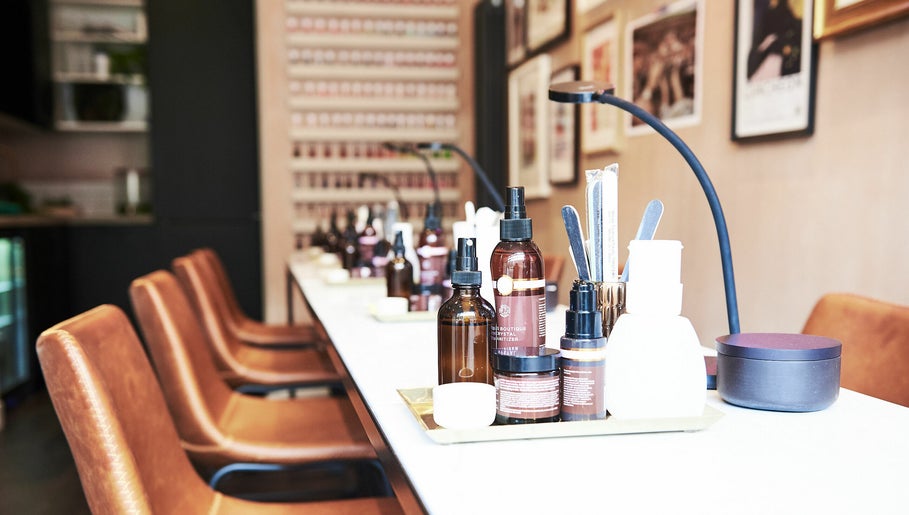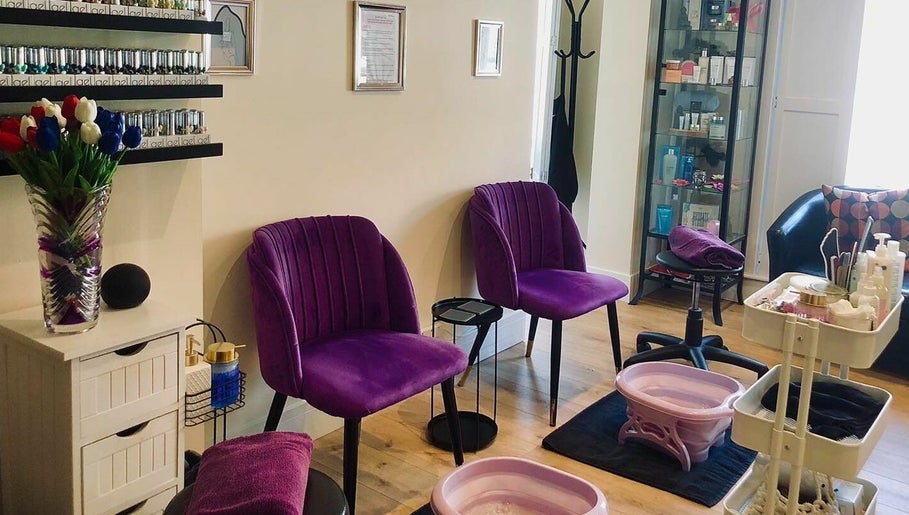
When was Nail Polish Invented: A Brief History and Timeline
Nail polish has a fascinating history, tracing its roots back to ancient civilizations. The invention of modern nail polish, however, began in the early 20th century, transforming beauty routines forever. If you're looking for a reliable nail salon near you, check out Gotonails.org for the best options.
Key Takeaways: Nail polish was invented in the 1920s, inspired by automotive paint technology. It was initially designed to enhance women’s beauty and gradually became a fashion statement.
The Origin of Nail Polish: A Beauty Revolution
The invention of nail polish as we know it today was a revolutionary step in beauty history. In the 1920s, nail polish became commercially available, thanks to French makeup artist Michelle Menard, who took inspiration from the glossy finish of automobile paints. This product was a significant leap forward from the tinted powders and creams used previously to color nails.
Early Forms of Nail Care
Before nail polish, ancient civilizations like Egyptians and Chinese used natural dyes and lacquers to color their nails. Cleopatra was said to favor red, while the Chinese royalty preferred gold and silver. These early forms of nail care reflected social status and wealth. However, the idea of using a fast-drying, glossy finish was unheard of until the early 20th century.
The Impact of Technological Advancements
The development of nail polish was driven by the discovery of nitrocellulose, a key ingredient in automotive paint. This chemical compound gave nails a glossy, durable finish, mimicking the look of freshly painted cars. By combining this formula with pigments, Revlon introduced a range of colored polishes in 1932, changing the beauty landscape forever.
The Influence of Fashion on Nail Polish
Fashion played a significant role in the rise of nail polish. Flappers in the 1920s embraced bold, red nail polish as a symbol of rebellion and freedom. As Hollywood actresses began wearing nail polish on screen, it became a must-have accessory for women aspiring to replicate the glamorous looks of their favorite stars.
How Nail Trends Have Evolved Over the Years
Since its invention, nail polish has evolved with changing fashion trends. In the 1960s, the psychedelic movement inspired neon and metallic polishes, while the 1990s saw the rise of grunge and darker shades like black and deep purple. Today, nail polish is available in an endless variety of colors and finishes, from matte to glitter, allowing individuals to express their personal style.
The Science Behind Nail Polish: How It Works
Nail polish is more than just a cosmetic product; it’s a blend of chemicals designed to protect and beautify nails. The main ingredients include nitrocellulose, solvents, resins, and plasticizers. These components work together to form a protective layer that adheres to the nail's surface and resists chipping.
What Happens When You Apply Nail Polish?
When applied, the solvent in the polish evaporates, leaving behind the pigments and resin, which hardens into a glossy layer. This process ensures the nail polish stays on for several days before it begins to wear off. Modern formulas also include ingredients that help improve nail health by adding nourishing oils and strengthening agents.
Innovations in Nail Polish Technology
Over the years, nail polish formulas have seen major improvements. Today, many brands offer non-toxic, vegan, and cruelty-free options. These polishes are free from harmful chemicals like toluene, formaldehyde, and dibutyl phthalate (DBP), making them safer for long-term use.
The Cultural Significance of Nail Polish
Beyond its beauty appeal, nail polish has cultural and societal significance. In different eras and cultures, it has symbolized power, rebellion, and self-expression. For example, during the suffragette movement, women painted their nails as a bold declaration of independence.
Nail Polish as a Form of Expression
In modern times, nail polish is often used as a tool for personal expression. The nail art movement, which started in the early 2000s, allows individuals to create intricate designs, reflecting their mood, identity, or even political stance. Celebrities and influencers have further popularized this trend, showcasing their creative designs on social media platforms.
Nail Polish and Self-Care: Why It Matters
For many, applying nail polish is more than just a cosmetic ritual; it’s an essential part of self-care. Painting nails can provide a sense of relaxation, helping individuals feel polished and put-together. It’s also a fun way to experiment with different looks and boost confidence.
The Role of Nail Polish in Wellness Routines
As part of a broader wellness trend, nail polish has become a symbol of self-love and personal care. People often integrate regular manicures into their routines as a way to unwind and take a break from their busy lives. Nail salons, such as those listed on Gotonails.org, offer pampering services that go beyond nail polish, providing an overall wellness experience.
Frequently Asked Questions
1. When was nail polish invented?
Nail polish in its modern form was invented in the 1920s, influenced by the automotive industry's glossy paints. The first colored nail polishes were developed by Revlon in 1932.
2. Who invented nail polish?
Although Michelle Menard is credited with the idea, it was Revlon that popularized nail polish in the 1930s by creating a wide range of shades that revolutionized beauty products.
3. How has nail polish evolved over the years?
Nail polish has evolved from a limited range of colors to a vast variety of shades and finishes, including matte, metallic, and holographic. Modern formulations also prioritize nail health with nourishing ingredients.
4. What are some common ingredients in nail polish?
Typical ingredients include nitrocellulose for the glossy finish, solvents to allow smooth application, and resins to make the polish chip-resistant. Today, many brands also offer formulas that exclude harmful chemicals like toluene and formaldehyde.
5. Where can I find a good nail salon near me?
If you’re looking for a top-notch nail salon, visit Gotonails.org. This platform helps you find highly-rated salons near you, offering quality service and professional care.
By understanding the history and cultural significance of nail polish, we can appreciate this beauty staple as more than just a cosmetic product. It’s a powerful tool for self-expression, wellness, and style.

“Discover Cassia Nail Spa, a vibrant salon in Menomonee Falls, WI (53051). Whether it's a repair or a fresh style, our skilled technicians ensure your nails look and feel amazing, guaranteed to catch eyes. With a focus on detail, every client receives exce”
“Racine Nails is a vibrant, yet comfortable nail salon in the heart of the Mount Pleasant/Racine County area. Whether you need a repair or a whole new style, our technicians will give you a look that not only makes you feel great about your nails but will”
“We carry top of the line products Our facility is clean and sanitation is our top priority. All materials are used only once. New tools are provided for each client(s) to accommodate the highest standards for our service(s). Our goal is to make our clie”
“Gloss is the premier Nail Salon in the Hall & Hayes area, offering Hard Gels, Acrylics, and many more trending Nail looks. With an extensive selection, we’ve got you covered for whatever you need. If you need self-love and care, a party or event in your f”

“Deeply attuned to client needs, our team at Shiloh Nails and Spa uses its expertise to provide you with the highest level of services. Choose your service starting from nail enhancements, manicure, pedicure, facial, eyelash extension, or massage to waxing”
“Ruby Nails is a fully licensed nail salon located in the Ruby Isle shopping center. We offer a variety of manicure and pedicure services. It is our goal to provide a friendly and relaxing atmosphere for all our clients. We strive for consistency in ev”

“Vogue Lashes & Spa in Sandbridge, Virginia Beach, features a complete range of services, including the highest quality individual eyelash extensions, lash lifts and tints, eyebrow shaping, permanent makeup, custom facials, bridal makeups, massage therapy,”

“Located in Columbia, MD, we are situated in the same shopping center as Victoria Gastro Pub. Our salon takes tremendous pride in customer service and customer satisfaction. As one of the top salons in Maryland, we are constantly improving our services to ”

“Indulge all your senses, let go of all of your worries, and get pampered with our exclusive spa services. Beverly Nails & Spa Boutique is located in Beverly, Massachusetts offering a range of beauty services that will enhance your natural beauty. What mak”

“Welcome to our full-service student salon, where you can experience top-notch services provided by students who have completed the initial phase of their training. Rest assured, all services are meticulously overseen by licensed educators, ensuring the hi”

“Posh Polish Nail Salon is a full-service nail salon located in Westfield, Indiana. We offer a number of services including manicures, pedicures, gel polish, acrylics, waxing and more. Book online with us today through Fresha! Our goal is to make each cli”

“Discover a sanctuary of beauty and relaxation at Vogue Lashes & Spa. Our certified specialists offer a comprehensive array of premium beauty services, tailored for both women and men. From enhancing your natural beauty with individual eyelash extensions a”

“Hello to Cherry Creek Nail Spa! We truly care about what goes on your nails and your body, so we offer you our best: - Experienced and talented nail technicians. - Nontoxic nail care products. - All natural ingredients, locally make in Colorado skin c”
“ManiCured is a nail salon located in Denver, Colorado. At ManiCured we created a business that would contribute positively back into the community in every way possible! We are one of the few salons who recycle, use eco-friendly products, and dispose of w”

“Serving the Greater Northshore (Essex County Massachusetts) and Greater Beverly Area, we offer manicures, pedicures, and wax services. Our top priority is your comfort and satisfaction. We strive to cater to your needs to where our service exceeds your e”
“We are a local salon focused on beauty, art, and supporting our community. Our staff is dedicated to providing a safe space for all clients; as a Dress Code Project partner our salon believes that everyone deserves self-care, no matter their age, gender-i”

“BeeQ Salon Spa, where our mission is to provide an unforgettable experience. With two Ann Arbor locations, our inviting spaces beckon you to unwind in our comfortable salon. Our warm staff attends to your personal care needs, leaving you beautiful inside ”
“Zen Day Spa "Living A Healthier YOU!" is a beautiful spa facility that specializes in Massages(MM#35768), Facials, Manicures, Pedicures, Nails, Foot Reflexology, Waxing, Raindrop Therapy, Chakra Balancing, Body Wraps...and more. If you don’t know which t”
“Hair and Nail Salon for the whole family. We offer a full range of hair & nail services, waxing, spray tanning. We bring many years of experience and a drive to satisfy every client every time. We look forward to having you in our chair!”

“At La Belle Vie Salon and Spa, there is nothing more remarkable than creating a place where individuals feel beautiful, remembered, taken care of and uplifted. To us, that is the optimum experience. We seek to discover, create, and exemplify beauty in e”

“Step in your one-stop beauty shop! At Vogue Lashes & Spa we offer a wide variety of services for both men and women that will make you feel beautiful from head to toe. Our exceptional team of dedicated professionals possess a genuine desire for not only y”

“Bubblicious Nails & Spa LLC is located in Staten Island, NY. Under New Management 06/16/2022 Our spa environment is designed to create the perfect atmosphere for our clients to completely relax and unwind. Tell us what your dream nails are, and we will”
“Here at Etoile Salon, our vision is not only to create a beautiful appearance but to nurture the spirit and relax the body and mind. Our goal is to lift and to challenge current industry standards. We offer a wide range of services and gift packages in wh”

“Ice Hair and Barbers brings quality hair styling & cuts for Women, Men and Children to Kingsway at affordable prices. Our young friendly team keeps up with the latest trends and provides a warm welcome.”

“Cuts ‘N’ Clippers Barbers is a family-run business with over 17 years of experience, dedicated to offering unisex haircuts tailored to your style. Our skilled team of barbers and hairdressers are here to refine your look to perfection. For beauty and male”
“Our skilled team specializes in treatments such as soothing massages, refreshing facials, precise waxing, and expert nail care. Each service is customized to meet your unique needs, ensuring a luxurious and personalized experience. Committed to using high”
“Beautiful, tranquil salon with plenty of free parking. We are massage specialists, including sports, hot stones and aromatherapy. We have holistic therapists who deliver reflexology and Reiki. Plus we offer a fabulous selection of facials including relax”
“Co-founded by session and celebrity manicurist Ama Quashie with salons based in Brixton and Leicester Square. The salon’s ethos is to amplify and accentuate the natural nail in all of its magnificent glory and adaptability. While offering premium traditio”
“Shoreditch Nails is a conscious beauty brand with studios in Shoreditch and Dalston, an Academy, and an eco-friendly polish collection. Our studios are a hub for self-care, creativity and a place for everyone to enjoy. Our Academy is a modern alternative”
“Hair, beauty & tanning salon, open 7 days and 5 late nights in Birtley. Our professional team offers all hair treatments, semi-permanent lashes, waxing, nail extensions and gel nails, manicures and pedicures, as well as a large selection of massage and fa”
“Beautie.LAB - Beauty & Aesthetics salon on New Beckenham High Street. Our mission is to gain your trust and win your loyalty. We are offering a wide range of beauty, nail & aesthetics treatments provided by fully qualified and highly experienced therapist”
“Blush + Blow London was founded by Bridget O’Keeffe, a makeup artist and entrepreneur 2016. She wanted to create a place with excellent customer service, that has great value for money with a fun, unique experience. As an SW6 resident herself, she knew ex”
“Bellissima is a Nail, Beauty and Aesthetic clinic situated in the heart of Hiltingbury Chandler’s Ford. Owned by Emma Marucci, an ambitious, quality-driven perfectionist with a genuine interest in all things beauty. Over the years, Emma has acquired expe”
“The Glow Up Nail Bar offers a full range of The Gel Bottle treatments, extensions, manicures and pedicures. Cruelty-free and vegan products are available at this chic pink Plymouth salon, where you can choose to add nail art for truly individual styled na”

“Shoreditch Nails is a conscious beauty brand with studios in Shoreditch and Dalston, an Academy, and an eco-friendly polish collection. Our studios are hubs for self-care, creativity, and a place for everyone to enjoy. The Academy is a modern alternative ”

“Beauty Salon in Wingham. Located next to Wingham Wildlife Park. Offering Million Dollar Facials, BIAB, Gels, Lash Lift, Brow Lamination, Lash Extensions, Brow Wax & Tint, Lash Tint, Waxing and SPMU Coming Soon! NEW CLIENT? Please make sure to contact you”
“The Avalon Rooms are the brain child of Flik Denham. Flik, one of the UK’s foremost award winning cosmetic and medical tattoo artists and body piercers, decided to open the Avalon Rooms in late 2019 after having sold her previous studio of 11 years. It wa”
“Yütopia spa located on Madeley High Street in the heart of Shropshire. Our Oriental inspired salon is designed with tranquil relaxation in mind. At Yütopia, you can relax the mind, soothe the soul, lift the spirit and escape from the world. Our aim is to”

“All our staff are trained in-house, the Boilerhouse way – from the ground up. Our extensive training scheme is complemented by ongoing training to keep the team on top of emerging hairdressing techniques. We strive to provide the highest standard in all ”

“Discover our esteemed nail salon, nestled in the heart of Braintree, Essex. We take pride in offering a warm and professional atmosphere where exceptional nail care is delivered with a friendly touch. Experience the perfect blend of expertise and hospital”
“From the moment you enter our salon you will experience a friendly, personal service that is second to none. Whether your visit is for the must have beauty essentials, one of our advanced skin care treatments or just muscular tension relief; you can rest ”
“If you're looking for an exclusive salon with a bespoke range of beauty services carried out by experienced beauty therapists, then Image is your answer. We provide top-quality services by our highly trained award winning team, that will leave you feeling”
“E-Nails is located in Waterloo, Huddersfield. The salon specialises in all ranges of nail enhancements including BIAB, Acrylic nails, Builder Gel nails, Shellac along with tinting, waxing, lash extentions, brow lamination, LVL and spray tanning treatmen”
“Vegan and Cruelty Free Nail Studio, Wellness Salon and Infrared Sauna. In pursuit of Wellness, STILL-London has been born. In an age where YOU matter, we bring you clean and toxic free beauty with unparalleled customer service in a calm and relaxing envir”
“Plaster Beauty is a boutique nail & beauty bar, located in the heart of Crystal Palace's Triangle, just a 10-minute walk from Crystal Palace station. This stylish salon opened in June 2019 and specialises in manicures and pedicures using vegan and cruelty”
“The Hair Gallery is a contemporary salon located in Waltham High Street. Our stylists are extensively trained and able to offer expert professional advice, specifically tailored to you. We only use the very best fashion haircare products to complement our”
“Auburn is a beautiful, relaxing salon based in the centre of Barnham in West Sussex. We are here to cater for both female and male clients alike and offer a full, professional range of services from haircutting, styling, barbering and colour services to D”





























“Enter a world of relaxation, pampering, and fun! Our nail services, spa treatments, and more are perfect for unwinding or hanging out with friends. It’s simple. We are dedicated to providing a memorable experience for each and every guest through exceptio”